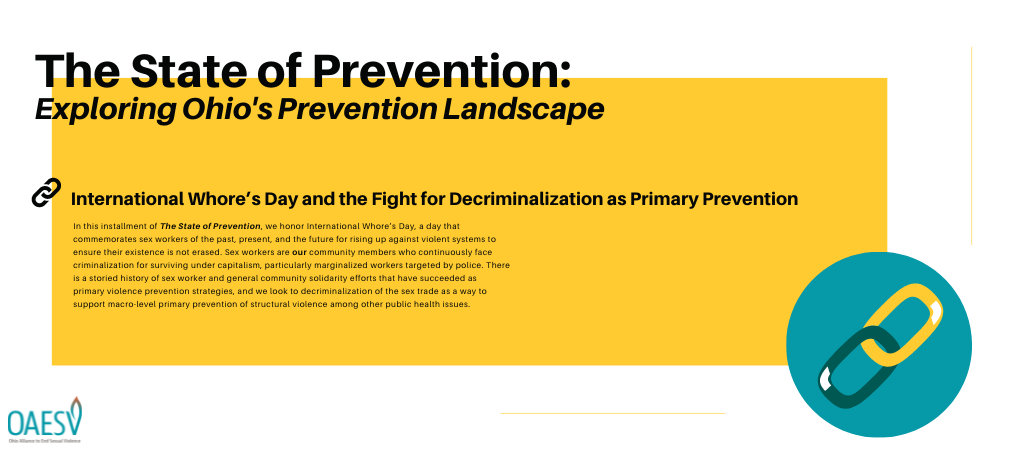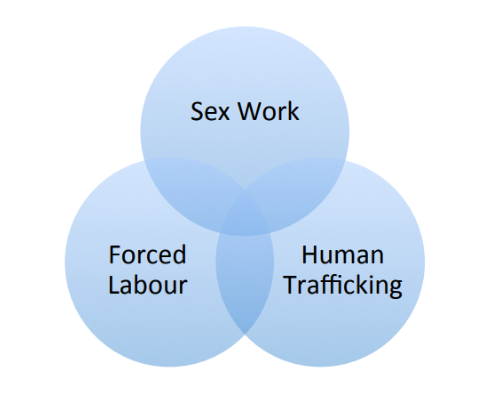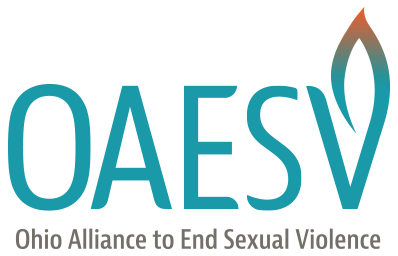
International Whore’s Day and the Fight for Decriminalization as Primary Prevention
“Being a whore isn’t a category of sexuality. It is a right to express one’s self as a worker.” 1 Today marks International Whores’ Day (IWD) 2, a day when sex workers rebelled against the systems that criminalized their existence. On June 2, 1975, over 100 sex workers began their eight-day occupation of Saint-Ninzier Church in Lyon, France to demand an end to fines, stigma, police harassment, and the release of ten sex workers who had been imprisoned days earlier for solicitation. Seeking refuge in the church was a strategic move, both as sanctuary for many who were facing imprisonment and to force the community to grapple with their moralistic complicity in state-sanctioned violence. The occupation ended with law enforcement forcibly removing the protesters and fueling collective worker solidarity throughout the world. Following the occupation, sex workers saw a drop in murders as well as increased organizing power within sex worker communities and with newly formed community allies surveilling police behavior. Community care3 structures were strengthened with active bystander behavior to quell police brutality incidents.
This historic occupation and its effects are just one example of many primary prevention4 strategies sex workers have undertaken to ensure their existence is not erased. We often connote primary prevention with theory and evidence-based programming, but we leave out the ongoing community efforts not typically recorded and implemented by communities not included in data and research. Sex workers all over the world have and continue to engage in mutual aid as a form of harm reduction5 and primary prevention. Emily Coombes, a researcher and organizer with the Las Vegas Sex Worker Collective and the Hacking//Hustling Collective, states, “At its core, mutual aid is about challenging the oppressive capitalist structures and social relations we live under in order to build community care and survive.” They go on to say, “State violence and abandonment of sex workers from social safety nets, police brutality, state and corporate surveillance, nation borders, mass incarceration, and rampant whorephobia are just some ways that criminalization works to cut off sex workers and their loved ones from vital resources, pushing them to engage in mutual aid.” These strategies include exchanging clean needles, sharing clients, swapping work advice, collectively raising children, distributing condoms and other barrier methods, developing “bad date” lists, screening information, sharing workspaces and outfits, creating support groups and bail funds, communal living, street surveillance, and more.
According to Red Umbrella Fund, “There are essentially three ways in which laws might negatively impact human rights of sex workers: by directly violating human rights; by shaping negative attitudes that result in weaker human rights protection for sex workers; and by putting sex workers in situations where they are more vulnerable.”6 For example, the criminalization of labor, specifically in the sex trade, leaves those buying and selling sex more vulnerable to violence, including police violence—both physical and sexual. This is especially true for Black trans women, who are multiplicatively oppressed and who may be forced to work in unsafe outdoor environments where police surveillance is more prevalent. This creates a cycle of violence in which sex workers cannot report criminal incidents to the police for fear of arrest and continued violence in their custody. Mutual aid is a direct response to the state’s failure to protect sex workers; it is a necessary tool for survival. But decriminalization of sex work can ensure that sex workers not only survive, but thrive.
The ACLU states, “Decriminalization refers to the removal of criminal penalties for the buying and selling of sexual acts, specifically those categorized as prostitution. Decriminalization is not the same as legalization.”7 Decriminalization can combat vulnerabilities and violence by including all forms of sex work under federally recognized labor laws, ensuring that workers have access to adequate standards of living for themselves and their families, rights to gain a living through work they rightly choose to engage in, equitable pay, paid leave, right to organize and unionize, safe working conditions, and healthcare coverage among other rights. In addition to labor protection access, it increases worker agency and safety by allowing workers to choose who they engage with, in what context, and under specific agreements. This is especially important for cash-poor workers who are at higher risk for STI and HIV contraction when forced to accept all clients to survive under surveilled capitalism and unable to carry condoms for fear of being arrested on this pretense.8 Labor protections, increased autonomy, and consensual contract agreements can all be considered protective factors9, serving as primary prevention strategies at multiple levels of the Socio-Ecological Model.10
Despite evidence supporting the institution of decriminalization policies as a far-reaching violence prevention strategy, we are seeing increased efforts to criminalize sex work as part of anti-trafficking policy frameworks. Ohio House Bill 27611, recently passed in the Ohio House, proposes banning individuals from receiving or acquiring money or anything of value if they know it was earned through sexual activity. The bill, sponsored by Reps. Jena Powell (R-Arcanum) and Jean Schmidt (R-Loveland), is intended to make human trafficker apprehension and prosecution easier, but trafficking language is not explicitly used in the proposed bill, increasing potential to target sex workers and their loved ones who depend on their financial support. Ken Schneck, editor of The Buckeye Flame, writes, “This could leave sex workers unable to buy things like groceries and diapers, while also criminalizing their sources of support, be they family assisting with childcare, landlord, convenience store owner, or even a health care provider.”12 While there are intersections with human trafficking due to the criminalizing nature of the labor, sex work at its core is consensual and voluntary; human trafficking is not. The decriminalization of sex work increases safety and support– especially for undocumented, LGBTQ+, disabled, and people of color workers– which can help to minimize forced labor of all types.

When we conflate sex work with human trafficking, we do not honor that sex work is work.13 Sex workers do not want to be rescued; they want rights. And that includes society acknowledging that their labor is as legitimate as all other labor operating under a capitalist structure. Survival under capitalism is a shared byproduct of the working class, all of whom engage with their labor in different ways and for different reasons. We must dispel the myth that the precarity of sex work is due to people’s forced engagement or a means to an end. One does not have to enjoy their work to remain in that workforce nor are all sex workers looking to leave the trade for something “better.” When we move away from these moralistic beliefs as a society, we help to shift social norms toward a protected environment for all workers. Decriminalization and destigmatization is about minimizing exploitation and increasing validity in both the buying and selling of consensual sex.
The first IWD demonstrated how spotlighting structural violence protected by the state is a community concern and, in turn, emboldened people to become active bystanders as a form of resistance. As we close out Asian American and Pacific Islander (AAPI) Heritage Month and begin Pride Month, it is imperative that we uplift the most vulnerable communities and those most targeted by the state—immigrant, people of color, disabled, undocumented, trans and gender non-conforming (TGNC), drug using, and poor communities. And when we begin to look at sex workers as part of our society, we may begin to learn intersectional approaches to harm reduction, community organizing, and public health, including HIV decriminalization, peer outreach, opioid-agonist-assisted treatment, increased healthcare accessibility and cultural responsiveness, mutual aid frameworks, inclusive domestic violence shelter protocols, prison abolition, sexual violence prevention, and anti-human trafficking strategies. This day reminds us that all workers deserve dignity, safety, and respect, with rights to organize and engage in the sex trade as a legitimate form of labor free from harassment and criminalization. On this day, we take guidance from efforts like California Prostitutes Education Project14, Street Transvestite Action Revolutionaries15, Durbar Mahila Samanwaya Committee16, Haymarket Pole Collective17, Red Canary Song18, and countless others who have a shared vision of sex worker solidarity. “International Whores/Sex Workers’ Day is many things – it is global, it is singular and collective, it is one day, and it is an un-ending annual tribute to taking up space, each of us, together, at once and for good.”19
Learn more about and donate to sex worker efforts throughout Ohio:
Cleveland Sex Worker Emergency Mutual Aid Fund
Works Cited:
1 Alisha Walker, International Whores’ Day 2020 Zine pg. 23
2 International Whores’ Day
3 Bryan Garcia, Some Thoughts on Community Care
4 Prevent Connect, Primary Prevention
5 SAMHSA, Harm Reduction
6 Red Umbrella Fund, Communications Toolkit
7 ACLU, It’s Time to Decriminalize Sex Work
8 Global Network of Sex Work Projects, The Impact of Criminalisation on Sex Workers’ Vulnerability to HIV and Violence
9 National Sexual Violence Resource Center, Risk and Protective Factors
10 Black Women’s BlueprintRecommended Socio-Ecological Model of Prevention
11 The Ohio Legislature, House Bill 276
12 8 Ken Schneck, Buckeye Flame; ‘Greater harm than good’: HB 276 already *PASSED* the Ohio House. Here’s why it’s dangerous for LGBTQ+ Ohioans.
13 Global Network of Sex Work Projects, Sex Work as Work
14 National Prevention Information Network, California Prostitutes Education Project
15 Global Network of Sex Work Projects, Street Transvestite Action Revolutionaries found STAR house
16 Global Network of Sex Work Projects, Durbar Mahila Samanwaya Committee
17 Haymarket Pole Collective
18 Red Canary Song
19 AP, International Whores’ Day 2020 Zine pg. 29
“The State of Prevention” is a blog series that explores Ohio’s prevention landscape, highlighting both history and current events that impact the field.
